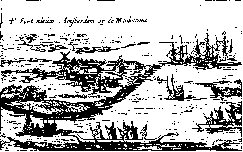Dutch Influences Remain
The Dutch possessed New Netherland, later to be called
New York, for 40 years. But they were not a migrating people.
Colonizing offered them neither political nor religious advantages
that they did not already enjoy in Holland. In addition, the Dutch
West India Company found it difficult to retain competent officials
to administer the colony. in 1664, with a revival of British interest
in colonial activity, the Dutch settlement was taken by conquest.
Long after this, however, the Dutch continued to exercise an
important social and economic influence. Their sharp-stepped,
gable roofs became a permanent part of the scene, and their
merchants gave the city its bustling commercial atmosphere.

The Dutch also gave New York a style of life quite different from that in Puritan Boston. In New York, holidays were marked by feasting and merrymaking. And many Dutch traditions - such as calling on one's neighbors on New Year's Day and celebrating the visit of Saint Nicholas at Christmastime - survived for many years.
With the transfer from Dutch authority, an English administrator, Richard Nicolls, set about remodeling the legal structure of New York. He did this so gradually and with such wisdom that he won the respect of Dutch as well as English. Town governments had the autonomous characteristics of New England towns, and in a few years there was a workable fusion between residual Dutch law and customs and English practices.
By 1696 nearly 30,000 people lived in the province of New York. In the rich valleys of the Hudson, Mohawk, and other rivers, great estates flourished. Tenant farmers and small independent farmers contributed to the agricultural development of the region. Rolling grasslands supplied feed for cattle, sheep, horses, and pigs; tobacco and flax were planted; and fruits, especially apples, grew in abundance. The fur trade also contributed to the growth of the colony. From Albany, 232 kilometers north of New York City, the Hudson River was a convenient waterway for shipping furs to the busy port.
